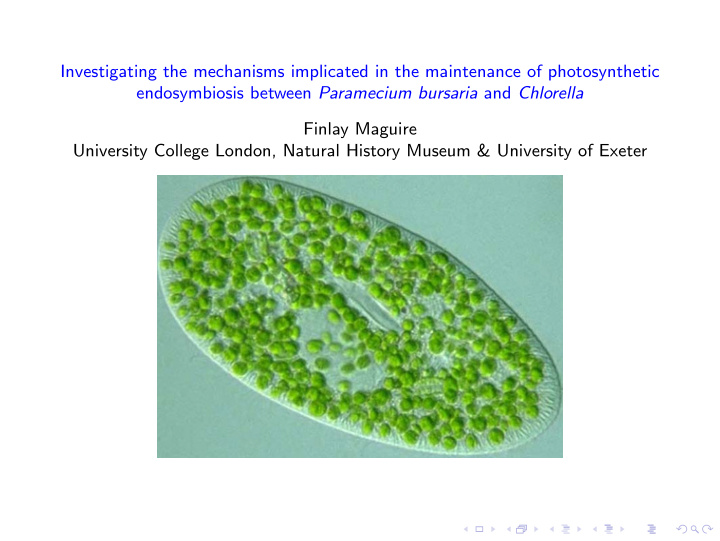



Investigating the mechanisms implicated in the maintenance of photosynthetic endosymbiosis between Paramecium bursaria and Chlorella Finlay Maguire University College London, Natural History Museum & University of Exeter
Background Biology ◮ Putatively facultative photosynthetic endosymbiosis between Paramecium bursaria , a ciliate, and Chlorella , a green algae ◮ One of the earliest studied micro-organisms (figure illustrated by Otto Muller in 1773) ◮ Complex, multi-factor relationship (on top of pure energetics: predation, photoprotection, thermotolerance, exploitation of low oxygen environments etc.) ◮ Theoretically forms and interesting and tractable system to study endosymbiosis before metabolic co-dependence becomes fixed
Transcriptomics on the system ◮ Day and night bulk RNA-Seq ◮ De-novo total assembly (pooled reads followed by remapping) ◮ Multiple assemblers and parameters used ◮ Referenced assemblies ( Coccomyxa ) but applicability of references requires fine-scale endosymbiont and host identification Assembly Metric Oases Assembly Trinity Assembly Min Contig Length: 100 201 Max Contig Length: 16,202 17,729 648.90 959.32 Mean Contig Length: 939.04 1080 Standard Deviation of Contig Length: 1,368 1,621 N50 Contig Length: Number of Contigs: 117,570 48,003 Number of Contigs ≥ 1kb: 22,225 14,774 Number of Contigs in N50: 14,977 8,060 Number of Bases in All Contigs: 76,290,606 46,050,097 Number of Bases in All Contigs ≥ 1kb: 46,695,005 31,602,626 GC Content of Contigs: 28.99% 30.97%
Confirming the identity of the host/endosymbiont ◮ rRNA fragments from within the transcriptome ◮ ITS2 sequencing ◮ ML and Bayesian phylogenetics ◮ Concluding: Referenced host assembly not applicable (not shown) but host ( Paramecium bursaria ) relatively distance, including 2 whole genome duplications from closest genome ( Paramecium tetraurelia )
Identifying transcript origin: problem formulation ◮ Metatranscriptome problem - most solutions geared towards environmental studies ◮ Diverse transcript origins (e.g. bacterial food sequences, other potential contaminants, as well as host and endosymbiont) ◮ Existing small-scale methods use relatively crude measures e.g. CDS calling, GC%, BLAST ◮ We tested how well these type of measures perform compared to manually evaluated phylogenies
Automated high-throughput transcript identification tool
Parallelised automated phylogeny generation and parsing ◮ Running using coarse parallelism (each transcript being processed using an individual node not requiring shared memory) - ‘supermarket queue’ ◮ Approximately 35% faster than serial multi-threaded execution of each step ◮ For each transcript: ◮ BLAST against curated database of 900 genomes ◮ Align recovered sequences using MUSCLE ◮ Automatically mask using TrimAL ◮ Generate rapid maximum-likelihood phylogenies using FastTree2 ◮ Once each phylogeny has been generated they can be parsed ◮ If categories have been decided vectors can be generated: ◮ Parse each phylogeny using ETE2 and recover N-nearest neighbours to transcript in phylogeny ◮ Using the NCBI taxonomy API determine taxonomy and categorisation of these neighbours ◮ Sum the reciprocal total distance for each category within the N-neighbours ◮ i.e. For the i -th phylogeny the j -th parameter in its feature vector will be 1 p =1 X p where X p corresponds to the tree distance between the transcript � n and the p -th neighbour (for the n ⊆ N neighbours s.t. n ∈ to the appropriate category).
Support Vector Machines ◮ Linear ◮ Non-linear classification: classification: ◮ Maximum ◮ Kernel margin solution functions (map + to feature regularisation space) ◮ Multi-class classification (e.g. ’Endosymbiont’, ’Host’, ’Food’, ’Unknown’): ◮ One-vs-all ◮ In-built
Assessing SVM function ◮ Optimise C and θ ◮ Error analysis ◮ Learning curves (Variance vs Bias) ◮ Precision (proportion of returned results that are relevant) / Recall (proportion of relevant results returned) ( F 1 Score)
Anomaly detection ◮ Generate multivariate Gaussians for each category (using labelled data) ◮ Assign a threshold ǫ ◮ If P ( X ) ≤ ǫ for each Gaussian then flag input at potentially anomalous ◮ Manually investigate the anomalies ◮ Tweak ǫ to maximise TP while secondarily minimising FP
Beginning metabolic reconstruction ◮ Use the transcripts as partitioned into host and endosymbiont origin to map onto KEGG metabolic networks ◮ GO and KO annotation of transcripts ◮ Combine KEGG modelling with differential expression data and known literature to identify putative candidates involved in the maintenance of the endosymbiosis
Evidence supporting theoretical model ◮ Figure adapted from [Kato & Imamura, 2009] ◮ Putatively differentially expressed ◮ 6 endosymbiont sugar transporters putatively differentially up-regulated ◮ 4 host cation transporters ( K + , Ca 2+ , Mg 2+ ) ◮ 2 endosymbiont cation transporters ( Ca 2+ , K + )
Summary ◮ Creation of an effective tool in resolving a key problem in multi-member transcriptome analyses ◮ Mapping and evaluating a complex data source in exploratory analysis ◮ Make predictions of key candidates for further investigation (still improving) ◮ Molecular validation of models and candidate proteins (in progress): ◮ Validate these predictions as having a role via RNAi ◮ System tested using Bug22 marker with mixed success ◮ Confirm differential expression (single cell transcriptomes/qPCR)
Recommend
More recommend